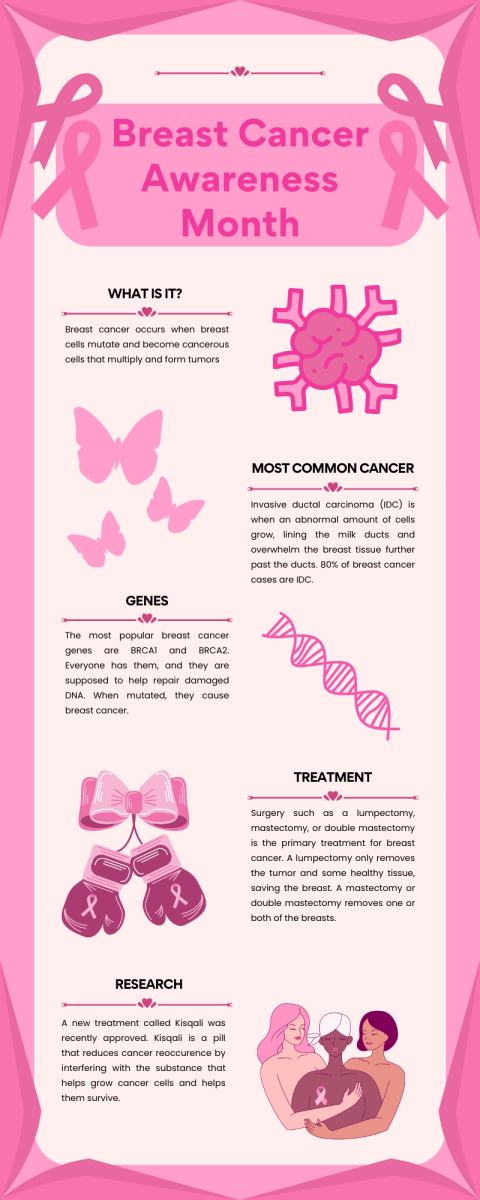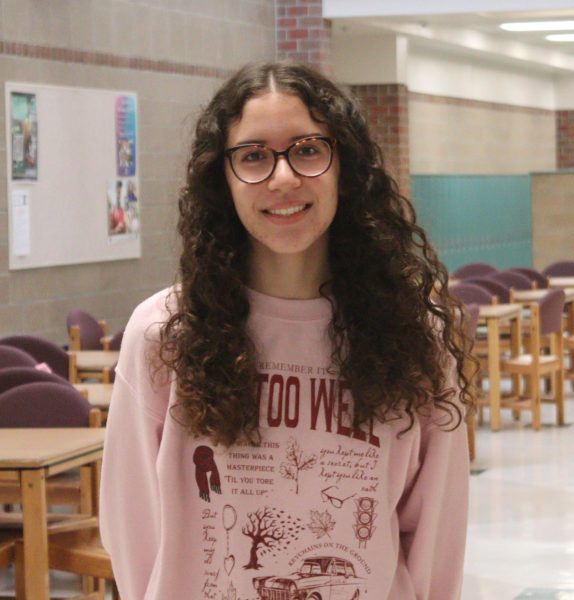October is Breast Cancer Awareness month, which means about 26,400 breast cancer cases will be diagnosed during this time. That averages to 851 cases every day, which can change someone’s life in a split second.
Breast Cancer is a cancer where a growth of cells occurs in the breast tissue. This cancer is the second most common cancer in women in the United States. Experts are not sure why the breast cells mutate and become cancerous but there are risk factors. Being above the age of 55, having a genetic mutation or family history, smoking or drinking and being exposed to radiation are all some risks that can higher your chance of developing breast cancer.
The most common type of breast cancer is Invasive Ductal Carcinoma, also known as IDC. IDC occurs when an abnormal amount of cells grow, lining the milk ducts, overwhelming the breast tissue further past the ducts. About 80% of breast cancer diagnoses are IDC. It is diagnosed by a mammogram, breast ultrasound, or biopsy. Cancer has different stages, which represent where it is located. Localized means that the cancer is within the breast, regional means it has spread to near areas in the body and distant means it has spread to farther areas like your lungs or bones.
When doctors diagnose a person with cancer, they say a stage zero through four. Stage zero means that there is only a potential for abnormal cells to develop into cancer, but that there isn’t currently cancer. Stage one is defined as cancer located in one area. Stage two and three mean that the cancer has become regional. Stage four indicates that the cancer is distant, also known as metastatic.
About 5-10% of breast cancer cases are caused by genes. The most popular and studied genes are BRCA1 and BRCA2, which stand for Breast Cancer gene 1 and 2. Everyone has these genes, but they can become dangerous when the genes are mutated. Even though I have a family history of breast cancer, my BRCA genes are not mutated. It is a scary thought to think about at such a young age. The five year survival rate for stage one breast cancer is 99%. For stage two and three, it is up to 86%, and for stage four, it is 31%. Stage four cancer is usually terminal, with most women only living up to one to two years after the diagnosis. Some can push through to up to 10 years, but it usually diminishes their quality of life.
The primary treatment for breast cancer is usually surgery. A lumpectomy is where the surgeon only removes the tumor, some healthy tissue around it and a couple of lymph nodes, which conserves the breast. A mastectomy is a surgery that removes the entire breast and some lymph nodes in the armpit. A double mastectomy removes both breasts completely. Fifty percent of patients who have had a mastectomy opted for breast reconstructive surgery. Cancer is one of the worst illnesses to go through and from what I’ve heard, most women prefer to get reconstructive surgery so that they can look at themselves and feel confident, people won’t feel pity towards them because they have a chest or just so they can slowly forget about them ever having surgery.
Although breast cancer is technically not fully curable, a new treatment was recently approved for breast cancer. The drug, Kisqali, was approved by the FDA on Sept. 18, 2024, and is now allowed to give to patients. This drug is supposed to reduce cancer recurrence. This can be given to any patient with breast cancer, as long as they’re high risk. The drug is a pill that is taken certain days on and off, suggested to be taken for three years. It interferes with the substance in your body that helps grow and allows cancer cells to survive. There are certain side effects like headache, nausea and fatigue, but this is a huge advance in research.
Breast cancer is an incredibly hard illness to power through mentally and physically. By being there for a person diagnosed, donating to research foundations and knowing more about the disease, you can help someone feel a little more comfortable during this tough part of their life.








